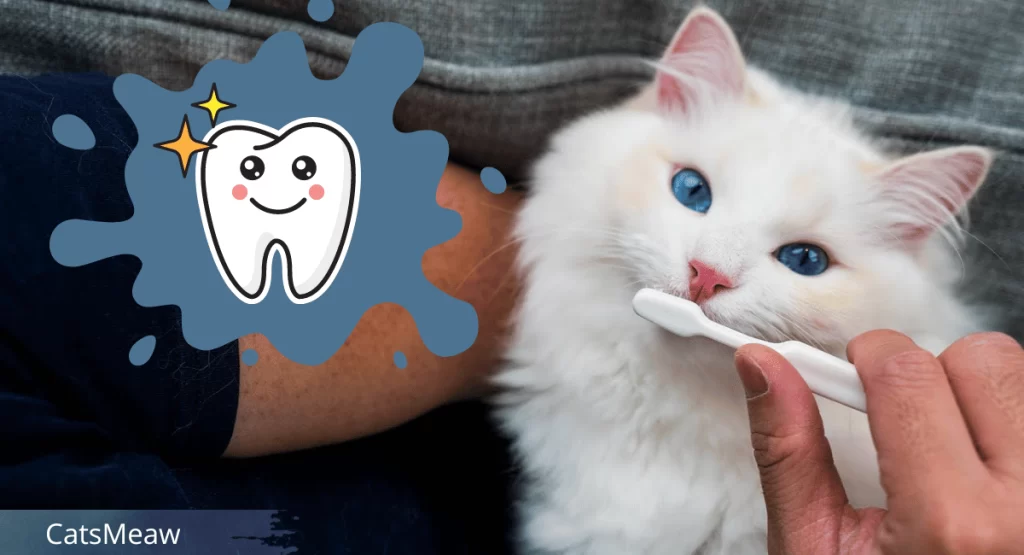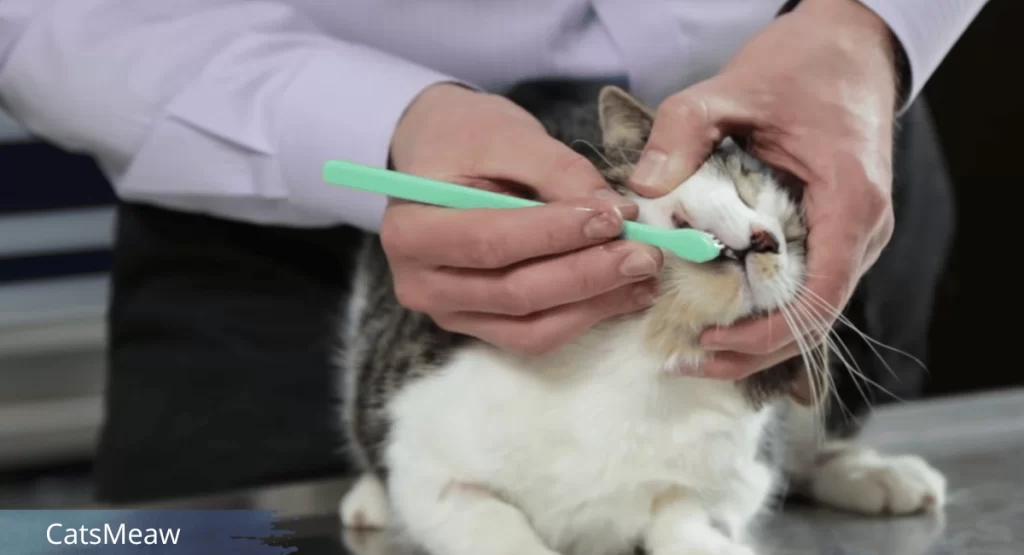If you are a cat responsible owner then you are supposed to prioritize your cat’s dental health. Just like humans, cats can suffer from dental problems that can cause discomfort and even lead to more serious health issues. One of the most effective ways to maintain your cat’s oral hygiene is by regularly brushing their teeth.
In this article, I will guide you through the importance of brushing your cat’s teeth, common dental problems in cats, how to introduce tooth brushing to your cat, choosing the right toothbrush and toothpaste, a step-by-step guide to brushing your cat’s teeth, tips for making tooth brushing a positive experience, alternative dental care options, how often to brush your cat’s teeth, and signs of dental problems in cats.

Table of Contents
The Importance of Brushing Your Cat’s Teeth
Maintaining good dental hygiene in cats is crucial for their overall health and well-being. Just like humans, cats may develop tartar and plaque buildup on their teeth, which mostly leads to tooth decay, gum disease and even tooth loss. Poor oral hygiene in cats can also result in painful infections that can spread to other organs in their bodies.
Regularly brushing your cat’s teeth helps remove plaque and tartar, preventing the buildup of harmful bacteria that can leads to some common cat’s diseases . It also stimulates their gums and promotes healthy blood circulation in their mouths. By making dental care a part of your cat’s routine, you can significantly reduce the risk of dental problems and ensure they have fresh breath.
Common Dental Problems in Cats
Cats are prone to several dental problems that can affect their quality of life. Some of the most known issues include:
- Gingivitis: This is characterized by inflamed gums and is usually caused by a buildup of plaque and tartar. If it is left untreated, gingivitis will progress to severe periodontal disease.
- Periodontal Disease: This is an advanced stage of gum disease in which the gums start to recede, leading to tooth decay, tooth loss, and bone damage. Periodontal disease can be painful for cats and may require professional dental treatment.
- Tooth Resorption: This condition involves the breakdown and loss of tooth structure, often starting at the gum line. Tooth resorption can be extremely painful for cats and may require tooth extraction.
- Bad Breath: Foul-smelling breath is a common sign of dental problems in cats. It is usually caused by the presence of bacteria in the mouth and should not be ignored.
How to Introduce Tooth Brushing to Your Cat
Brushing your cat’s teeth can be a gradual process to ensure they feel comfortable and cooperative. Follow these steps to make the experience as positive as possible:
- Start Slowly: Begin by gently touching your cat’s mouth and teeth with your fingers. This will help your cat to build trust and get used to the sensation.
- Choosing the Right Time: Find a calm and quiet environment where your cat will feel relaxed. Avoid forcing the toothbrushing session if your cat seems stressed or anxious.
- Use Tasty Rewards: Associate tooth brushing with positive experiences by rewarding your cat with treats or praise after each session. This will create a positive association with the activity.
- Gradually Introduce the Toothbrush: Start by letting your cat sniff and lick the toothbrush. Once they are comfortable, gently rub the toothbrush along their gums and teeth in a circular motion.
- Increase Duration: Gradually increase the duration of each tooth brushing session as your cat becomes more accustomed to the process. Aim for a few minutes of brushing every day for optimal dental care.
Choosing the Right Toothbrush and Toothpaste for Your Cat
Selecting the appropriate toothbrush and toothpaste is crucial for effective dental care. Here’s what you need to consider:
- Toothbrush: choose a toothbrush that is specifically designed for cats. These brushes usually have soft bristles and a smaller head, making it easier to navigate around your cat’s mouth.
- Toothpaste: Never and ever use human toothpaste for your cat, as it can be toxic to them. Instead, opt for toothpaste formulated specifically for felines. These toothpastes come in flavors that appeal to cats, such as poultry or seafood.
- Finger Brushes: If your cat is resistant to using a traditional toothbrush, you can try a finger brush. These brushes fit over your finger and allow for more precise brushing.
- Consult Your Veterinarian: If you’re unsure about which toothbrush and toothpaste to choose, consult your veterinarian. They can provide recommendations and guide you based on your cat’s specific needs.
Related: The Importance of Regular Veterinary Check-ups for Cats
By selecting the right tools for the job, you can ensure a comfortable and effective tooth brushing experience for your cat.
Step-by-Step Guide to Brushing Your Cat’s Teeth
Now that you have the necessary tools and knowledge, let’s dive into the step-by-step process of brushing your cat’s teeth:
- Get Your Cat Comfortable: Find a quiet space where you and your cat can relax. Consider placing a towel or blanket on a stable surface, such as a table or countertop, to provide a comfortable area for your cat.
- Introduce the Toothbrush: Let your cat sniff and investigate the toothbrush before starting. Allow them to lick a small amount of toothpaste from the brush to familiarize themselves with the taste.
- Gently Hold Your Cat: Gently hold your cat’s head and use your non-dominant hand to lift their lip, exposing their teeth and gums. Take it slow and be mindful of your cat’s comfort level.
- Brushing Technique: Hold the toothbrush at a 45-degree angle and brush in a circular motion. Focus most of time on the outer surfaces of the teeth, as that’s where tartar and plaque may be accumulated the most.
- Be Patient and Persistent: Initially, your cat may resist or try to escape. Stay calm and continue with the brushing, even if it’s only for a few seconds. With time and patience, most cats become more cooperative.
- Reward and Praise: Once you finish brushing, reward your cat with a treat or a special meal. This positive reinforcement will reinforce the idea that tooth brushing is a rewarding experience.
Remember, consistency is key. Aim for daily brushing sessions to maintain optimal dental health for your feline friend.
Tips for Making Tooth Brushing a Positive Experience for Your Cat
Tooth brushing can become a positive experience for your cat with these helpful tips:
- Start Early: Introduce tooth brushing to your cat at a young age to establish it as a normal part of their routine.
- Be Patient: Cats may take time to adjust to tooth brushing. Stay persistent, patient and calm throughout the process.
- Use Gentle Movements: Be gentle when brushing your cat’s teeth to avoid causing any discomfort or distress.
- Reward and Praise: Always reward your cat with treats, praise, or playtime after each tooth brushing session to create a positive association.
- Consult Your Veterinarian: If you encounter difficulties or your cat consistently resists tooth brushing, consult your veterinarian for additional advice and guidance.

Making tooth brushing a positive experience will benefit both you and your cat in the long run.
Alternative Dental Care Options for Cats
While brushing your cat’s teeth is the most effective way to maintain your cat’s dental health, there are alternative options to supplement their oral care routine:
- Dental Treats: There are various dental treats available that are specifically designed to promote oral health in cats. These treats can help reduce plaque and tartar buildup.
- Dental Wipes: If your cat is resistant to tooth brushing, dental wipes can be a good alternative. These wipes are specially formulated to help remove plaque and bacteria from your cat’s teeth.
- Oral Rinses and Gels: Oral rinses and gels can be used as an additional step in your cat’s dental care routine. Consult your veterinarian for recommendations on safe and effective products.
While these alternatives can be helpful, they should not replace regular tooth brushing. They can be used in conjunction with brushing to enhance your cat’s overall dental health.
How Often Should You Brush Your Cat’s Teeth?
To maintain optimal dental health, aim to brush your cat’s teeth at least three times a week. However, daily brushing is ideal for preventing dental problems. Consistency is key in keeping your cat’s teeth clean and their oral health in check.
Signs of Dental Problems in Cats
Being aware of the signs of dental problems in cats can help you identify issues early on. Look out for the following indicators:
- Bad Breath: Persistent foul breath is often a sign of dental problems in cats.
- Red or Swollen Gums: Inflamed or bleeding gums can indicate gum disease or other dental issues.
- Difficulty Eating: If your cat is avoiding certain foods or showing signs of discomfort while eating, it could be due to dental pain.
- Excessive Drooling: Excessive drooling can be a sign of dental problems, especially if it is accompanied by other symptoms.
- Pawing at the Mouth: If your cat is frequently pawing at their mouth or showing signs of discomfort around their face, it may indicate dental pain.
If you notice any of these signs, it’s crucial to consult your veterinarian for a thorough dental examination.
Related: How to Bathe a Cat: Best Bath & Grooming Tips
Caring for your cat’s teeth is an essential aspect of their overall health and well-being. By regularlybrushing your cat’s teeth, you can prevent dental problems, maintain fresh breath, and ensure they live a comfortable and pain-free life. Remember to introduce tooth brushing gradually, choose the right tools, be patient and persistent, and reward your cat for their cooperation.
If tooth brushing proves challenging, explore alternative dental care options, such as dental treats or wipes. By prioritizing your cat’s dental health, you are taking a proactive step towards ensuring their long-term happiness and quality of life.
